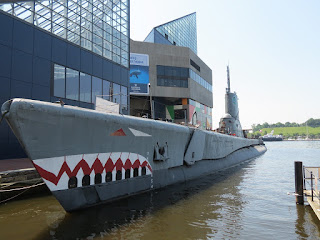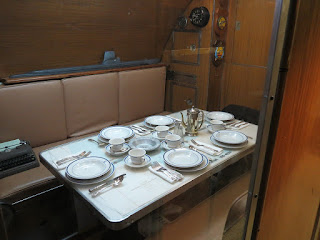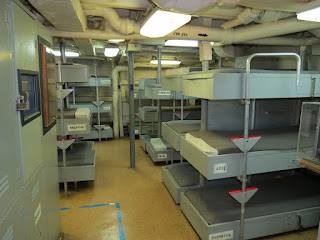After putting it off for some time, I finally did the historic ship tour located at the Inner Harbor of Baltimore, Maryland. Opting to tour three of the four ships.
The ships on my tour included the USS Constellation, a U.S. Navy sloop-of-war built in the mid-1800s that saw action in the United States Civil War, engaged in slave ship interdiction, commerce protection, and served as a training vessel; the US submarine Torsk, which served during World War II; and the USCGC Taney, a Coast Guard cutter that saw extensive service in World War II and Vietnam.
Together, these ships are representative of two distinct eras of navel technology. But each served as an answer to the needs of their time and situation. Collectively, they shared the common goal of protecting American interests at sea.
USS Constellation
I have had a fascination with tall ships since early childhood, so I was eager to tour the USS Constellation.The sloop-of-war is one of the few original all-wooden, all-sail ships remaining in the United States.
.JPG) |
| The USS Constellation, launched in 1855. |
.JPG) |
| The ship had three masts. This image shows much of the ship's complex rigging. Each rope served a function in sailing the ship. On each side of the mast, the rat-lines, which look like webbing, can be seen. Sailors used the rat-lines to climb up the masts to manage the sails. |
.JPG) |
| The ship's helm. Many large sailing vessels such as this one had two helms, allowing for greater control of the ship during heavy seas. Each helm here is a little over 5 feet tall. |
.JPG) |
| The gun deck, located just beneath the main deck. |
.JPG) |
| The captain's quarters, located in the back of the ship on the gun deck. By far the nicest part of the ship, the captain's quarters had a large dining/meeting table, a comparatively spacious private cabin and wash room. |
.JPG) |
| The next deck down below the gun deck housed the officers' quarters. Like the captain's quarters, the officers' quarters featured a smaller private cabin for each officer and a dining/meeting table. |
.JPG) |
| The hammocks for the rest of the crew. The crew also ate their meals on the floor. There was also much less ventilation on this deck. |
.JPG) |
| The repair shop. While out at sea, the ship could sustain damage from rough seas or combat thousands of miles from a harbor, so it was essential to have a workshop to make necessary repairs. |
.JPG) |
| The amputation table, located forward of the crews' hammocks. Those unfortunate enough to have to experience being on this table had to endure amputations as a result of combat wounds. The doctors had to work with limited lighting, tools, and rolling from heavy seas. |
.JPG) |
| Deep in the bowels of the ship. Here the frames of the ship are visible on the right and left. On the bottom, weights used for ballast to provide center of gravity for stability can be seen. It was in this section that most of the ship's ordinance, food and water was stored during voyages. |
USS Torsk
.JPG) |
| The USS Torsk, commissioned in 1944. |
.JPG) |
| The captain's sleeping cabin. It looked very cramped, but compared to the sailors' bunks located in the submarine's passageways, it was far better. |
.JPG) |
| The officers' dining table. |
.JPG) |
| The "sonar shack". When submerged, this room was essentially the eyes and ears of the submarine. |
.JPG) |
| One of several control rooms throughout the submarine. |
.JPG) |
| An evaporator that converted salt water to fresh water. It was capable of converting approximately 1,000 gallons per day. At that rate, the sailors could shower once per week after all other water needs were satisfied. |
.JPG) |
| A series of bunks were the rest of the sailors slept. They were stacked three high and had about 3 feet clearance between each. Normally, there would only be a dim red light for illumination and working crew were supposed to be as quiet as possible when passing through, since most of the time part of the crew sleeping here. |
.JPG) |
| The common mess area where the crew ate their meals. |
.JPG) |
| The radio control room. |
.JPG) |
| The main control room. The periscope was also located in this room. |
USCGC Taney
.JPG) |
| The USCGC Taney, was launched in 1936. The Taney saw extensive action, including defending Pearl Harbor on December 7, 1941, anti-submarine patrols, and conducting missions during the conflict with Vietnam. |
.JPG) |
| The engine room, containing the 6,000 horsepower engines. |
.JPG) |
| The sailors' cafeteria. Compared to sailors' accommodations on the USS Constellation and US Torsk, this dining area seemed luxurious. |
.JPG) |
| The sailors' bunks. |
.JPG) |
| The armory, were weapons were serviced. |
.JPG) |
| The barber shop. |
.JPG) |
| The ship's main armament. |
.JPG) |
| The pilot room. |
.JPG)
.JPG)
.JPG)
.JPG)
.JPG)
.JPG)
.JPG)
.JPG)
.JPG)
.JPG)
.JPG)
.JPG)
.JPG)
.JPG)
.JPG)
.JPG)
.JPG)
.JPG)
.JPG)
.JPG)
.JPG)

.JPG)
.JPG)
.JPG)
.JPG)
.JPG)
.JPG)
.JPG)
No comments:
Post a Comment